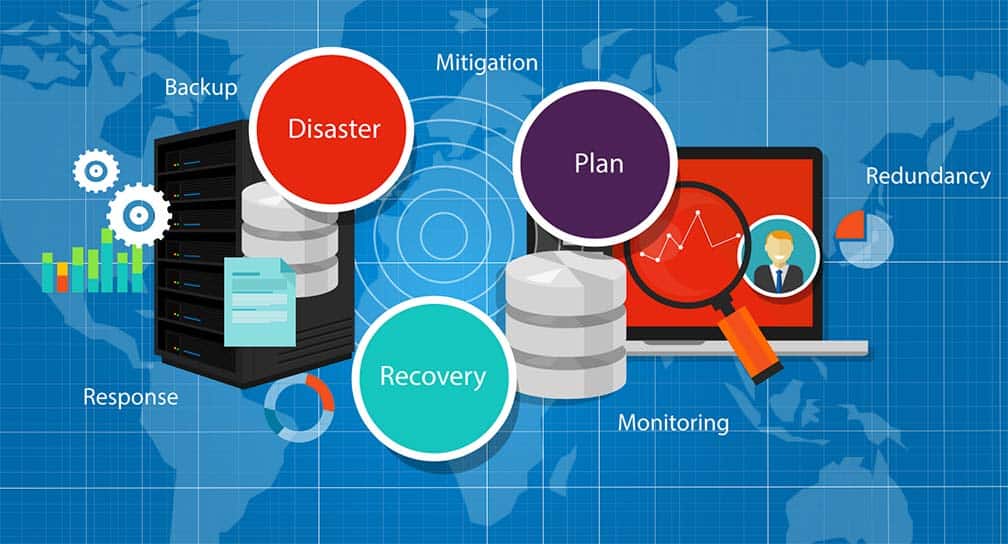Many rely on digital resources now, and that’s why disaster recovery solutions have become critical to a business strategy. It can save your ship in troubled waters by being a lifeboat, providing support during unexpected crises.
What is disaster recovery?
Disaster recovery protocols are put in place to safeguard a business’s IT infrastructure against unexpected disruptions, which could range from natural calamities like floods or fires to cyber-attacks, equipment breakdowns or even errors committed by people associated with the enterprise. Their implementation prepares an organization for contingencies well in advance.
Disaster recovery is essentially preparing for the worst and having an action plan ready to minimize damage and quickly restore business operations.
Why is a disaster recovery plan important?
Disasters happen, and you can’t always avoid them. In the business world, it’s wise to hope for the best but prepare for the worst with a robust disaster recovery plan. By doing so, your business can be ready to face any crisis head-on and minimize downtime while reducing data loss. It also helps maintain customer trust—a priceless commodity in today’s competitive market.
The Five Phases of a Disaster Recovery Plan
Breaking a disaster recovery plan into its parts is critical to understanding it. It’s like embarking on a journey – your business moves from being vulnerable to having resilience and readiness. The journey comprises five phases, each representing an essential aspect of the recovery strategy.
The cyclical process of disaster management consists of several phases, namely: Preparation, Protection, Detection and Alert, Response, and Recovery. These stages are interconnected and crucial in building a resilient business against potential hazards. By evaluating and refining these processes regularly, the plan becomes more comprehensive over time.
Let’s explore the five critical phases of disaster recovery – their purpose, intricacies, and fundamental role in a comprehensive plan. Through this journey, businesses can equip themselves with the knowledge to steer clear of potential dangers and sail towards security and resilience. This will certainly help navigate through tumultuous times while ensuring a disaster-free future.
Phase 1: Preparation
When it comes to disaster recovery planning, preparation is key. Think of it like an architect creating a blueprint for a building. This involves conducting a thorough risk assessment and identifying potential threats such as natural disasters, cyber-attacks, or human error that could impact your business operations. You must then analyze the likelihood and potential impact of these threats on your business while also determining the most critical business functions that must be prioritized during recovery. Lastly, set out clear recovery objectives detailing acceptable data loss and maximum tolerable downtime for each operation.
Phase 2: Protection
To keep your digital world secure, think of it as a castle that needs fortification. This involves taking multiple steps to protect your information and IT infrastructure. One critical measure is making regular data backups so that you can recover from any disaster with minimal loss. You should also implement robust network firewall security and top-notch antivirus software to defend against cyber threats. Redundancy is another essential consideration, ensuring that secondary systems can step in immediately – if the worst happens – for uninterrupted business.
Phase 3: Detection and Alert
When it comes to avoiding disaster, the old adage “forewarned is forearmed” holds true. To give yourself the best chance of success, you need to be able to detect any potential threats as soon as possible. Putting a system in place that can do this in real-time is essential – think intrusion detection systems or server monitoring tools. You may even want employees reporting manually. Once something has been detected, it’s crucial that those who need to know are alerted ASAP: fast responses make all the difference when things get tough.
Phase 4: Response
When disaster strikes, it’s time to put your disaster recovery plan into action – this is the moment of truth. To mobilize your team and restore critical services as fast as possible, clear communication with all stakeholders, including employees, customers, and partners, is crucial during this stage. Keep everyone informed about the situation regularly while minimizing downtime.
Phase 5: Recovery
Now that the immediate crisis is under control, it’s time to focus on recovery. This crucial phase involves restoring your business operations back to normal. It may require fixing any damaged hardware, restoring data from backups, or even reevaluating and revising your business strategies based on the impact of the disaster. Remember, your disaster recovery plan isn’t something you do once and forget about; after each crisis, take some time to review and refine it based on your experiences so that you’re better prepared for future challenges.
Cynergy Technology Disaster Recovery Services
Of course, constructing and implementing an effective disaster recovery plan is no easy task. That’s where Cynergy Technology comes in. Our dedicated team, backed by years of experience and a comprehensive understanding of diverse business needs, is adept at helping businesses like yours plan for the unexpected. With Cynergy Technology, you can rest assured that your business is prepared to weather any storm. Contact us today to learn more about how we can help.







